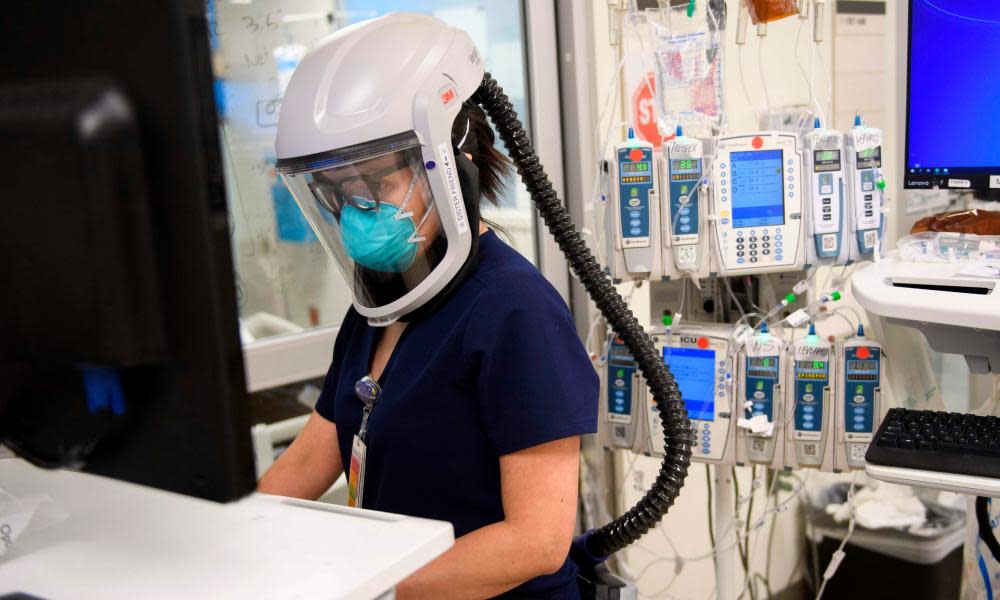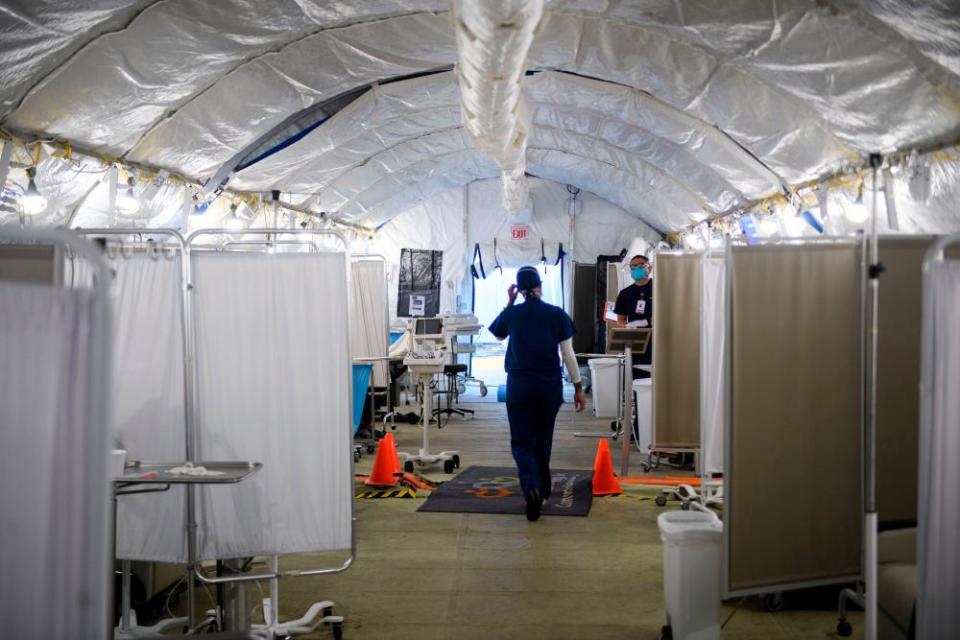'The horror stories are countless': inside the LA hospital at the center of the Covid crisis
- Oops!Something went wrong.Please try again later.

Husbands and wives, twin brothers in their 20s, parents and their children. Family members are turning up one after another at Martin Luther King Jr community hospital (MLKCH) in South Los Angeles. The deaths have been piling up.
Patients have been arriving at MLKCH terribly sick, and at higher rates than anywhere else in the region – the impoverished Latino and Black neighborhood is one of the worst Covid hotspots in America. Inside the hospital, staff face a dire scramble to ensure they have the supplies, the healthcare workers and the physical space needed to take care of the overwhelming crush of Covid victims.

“The horror stories are countless,” Dr Jason Prasso, an intensive care unit doctor, told the Guardian on a recent morning while on a break inside an ICU office. On the other side of the door, a line of patients lay on gurneys in a narrow hallway, with doctors passing by in enclosed air-purifying helmets. He said nearly half did not survive the ICU: “We try and stave off complications, but there’s nothing I can do to reverse the course of the virus.”
At times in recent weeks, the small 131-bed community hospital has seen proportionally more Covid patients than any of the nearly 50 other hospitals in the LA area. Some days, it is treating nearly double the number of patients for which it normally has capacity.
MLKCH has put beds in an old gift shop, which has a small sign on the door indicating “patient care in progress”. The chapel around the corner is filled with gurneys. Patients are treated in the waiting room and doubled up in spaces meant for one. Outside the building, there are five triage tents for intake.
“With this new surge, we’re finding the patients are much sicker, and it’s not clear why,” said Anahiz Correa, the ICU nurse manager. She recounted a mother and son who ended up dying in the same ICU room weeks apart.
“I don’t even know what to say any more. Everyone says, ‘Continue social distancing and wearing your mask,’ but at this point the situation is so dire.” Now, Correa’s advice is that families should have tough conversations about their wishes if they become incapacitated or die.
The first week of 2021 has been terrifying for much of southern California, which is by many measures battling the worst Covid catastrophe in the US. The sounds of sirens are constant. In LA, one person is contracting Covid every six seconds, one person is dying every eight minutes and one in 17 residents may now be infectious. Hospitals are so overrun that officials have directed crews not to transport patients who have little chance of survival, and some ambulances are waiting eight hours to offload patients.
The crisis is expected to further deteriorate as infections from Christmas and New Year’s Eve escalate.
But the toll of the pandemic is not equal, and nowhere is that clearer than inside the halls of MLKCH, where most Covid patients are Latinos. They are not the Angelenos flouting the government’s guidelines, but rather the essential workers who can’t escape the virus, who have had no option but to continue dangerous jobs during the worst phase of the pandemic yet. And many were already sick before Covid arrived.
A ‘separate and unequal’ system
“The hospital is surrounded by a sea of chronic illness and lack of access to healthcare,” said Dr Elaine Batchlor, the CEO of MLKCH.
Related: 'Everywhere you look, people are infected': Covid's toll on California Latinos
The hospital is located just south of the Watts neighborhood, where the historic riots of 1965 put a national spotlight on racist policing and segregation in southern California. When it opened in 2015, it was fulfilling a promise that grew out of those uprisings – to improve healthcare in the historically Black neighborhood.
Only 4% of MLKCH’s patients have private health insurance, and because doctors are reimbursed at low rates for care subsidized by the government, South LA has an overall shortage of 1,200 doctors. Local people end up at MLKCH at the end stages of chronic illnesses that have gone untreated, and the ED in normal times is one of the busiest in the region.
Amputations and wound care for diabetics are the most common surgical procedures, Batchlor said. The neighborhood, now majority Latino, has significantly higher rates of heart attacks, strokes and overall mortality than the rest of LA. The “separate and unequal” health system that perpetuates these disparities has become even more visible during the pandemic.
In Cedars-Sinai, known for treating Hollywood celebrities, Covid patients have made up roughly 23% of its capacity in recent weeks. Twenty miles away at MLKCH, it’s 97%.
“Covid is preying on essential workers, and many don’t have insurance … These are the bus drivers, they stock the grocery shelves, they are cleaners. So they’ve continued to be exposed,” Batchlor said, noting that they often could not isolate at home. “If one member of the family gets sick, the rest of the family is likely to get sick.”
Covid has provided a grim illustration of how LA’s longstanding housing crisis is a public health catastrophe; the region is a leader in overcrowded housing, which has further spread the virus among vulnerable populations. Since many in the region were in poor health even before the pandemic, MLKCH’s Covid patients are younger than those in other hospitals – and more likely to die.
The scramble for oxygen and staff
“It’s just wall to wall. It’s all backed up,” said Gwendolyn Driscoll, a senior communications director at the hospital, as she walked through the noisy emergency department. The hospital was so full at the end of December, she explained, that it had to formally declare an “internal disaster”, which temporarily diverted ambulances from showing up – “the first time ever in our history”. She pointed to rooms that have been converted into “negative pressure” zones for infectious patients.
The hospital once had separate wings for Covid. Now, positive patients are on every floor. Araceli Martinez, the charge nurse on the fourth floor, explained that her floor had originally been “clean” (without Covid), but now had 29 positive patients.
“It’s physically and emotionally draining,” she said, noting that a single nurse could be caring for six very sick Covid patients at once: “We’re used to giving all we can.” Patients on her floor are doubling up in single rooms. As she spoke, another nurse over the loudspeaker called for “rapid response” to a room where a patient was in crisis.
Secelia Dean, a supervisor who helps coordinate staffing, said that the hospital would typically hire travel nurses to handle a surge in patients, but was struggling now: “They are in demand everywhere because of this pandemic – Texas, Atlanta, everywhere. We are outnumbered.”
While the hospital is used to responding to crises and continues to function relatively smoothly, it could run out of options if the numbers get much worse. Batchlor said she had difficult conversations with staff who told her how they were building space for new patients: “We add more beds, we add more patients, and the same number of people continue to take care of them.” Meanwhile, more burned-out staff members are taking leaves of absence.
Finding the life-saving equipment needed to treat more patients is also a daily challenge. On the administrative floor, Jonathan Westall, vice-president of ancillary services, said the process of tracking down oxygen tanks had become increasingly chaotic. Patients would typically be plugged into wall oxygen in their rooms, but now that they were in tents, hallways and other makeshift quarters, the hospital needed more “grab and go” oxygen tanks (which are normally used just for brief periods of transportation).
“We have three times the number of patients we normally would have, and most patients now have respiratory distress,” he said, noting that local vendors were not prepared for this kind of surge. And the tanks have to be refilled. “I’m cold-calling everybody or anybody, making 100 calls a day … or I’ll put a guy in a truck with 50 tanks and send him to a plant and tell him to stand outside.”
At times, the purchases came down to the wire, he said. “We’re going to get 50 at 4pm, or we’re not going to get any, and I’m going to run out at 8pm.”
Batchlor said when the on-site morgue had become full, the hospital had been forced to bring in a refrigerated truck, which had then begun filling up, too: “Now we’re putting shelves in it, so we can fit more bodies.”
‘I wouldn’t wish this on anyone’
Juliana Jimenez Sesma, 41, had to send both her mother and stepfather to MLKCH after at least 10 of her family members were infected in November. Her parents died 11 days apart in December.
Her 66-year-old mother, who had worked as a machine operator, had pulmonary fibrosis and had already depended on oxygen before she got Covid. Her handyman stepfather, 54, had diabetes and asthma. The three of them lived together and all got sick.
When she first took her parents to see a doctor, they prescribed cough syrup and did not suggest the couple might have Covid. The family had not realized the virus had infected them until the hospitalizations, and they did not know how they got it, she said.
“I would never want no other family to go through what we are going through,” she said, noting that when she said goodbye to her mother in the morgue, she couldn’t touch her because doctors had said it wasn’t safe.
In South Los Angeles, a socially distant parking lot funeral for Maria Guadalupe Sesma, 66, who died of Covid eleven days after Covid killed her husband, Alberto Reyes, 54. pic.twitter.com/XSqCaDRVpm
— Sam Levin (@SamTLevin) January 11, 2021
On a recent afternoon, her family held an outdoor funeral in a church parking lot three miles from the hospital. Everyone wore coverings and face shields. A mariachi band played, wearing masks while singing. Attendees made sure not to hug each other.

